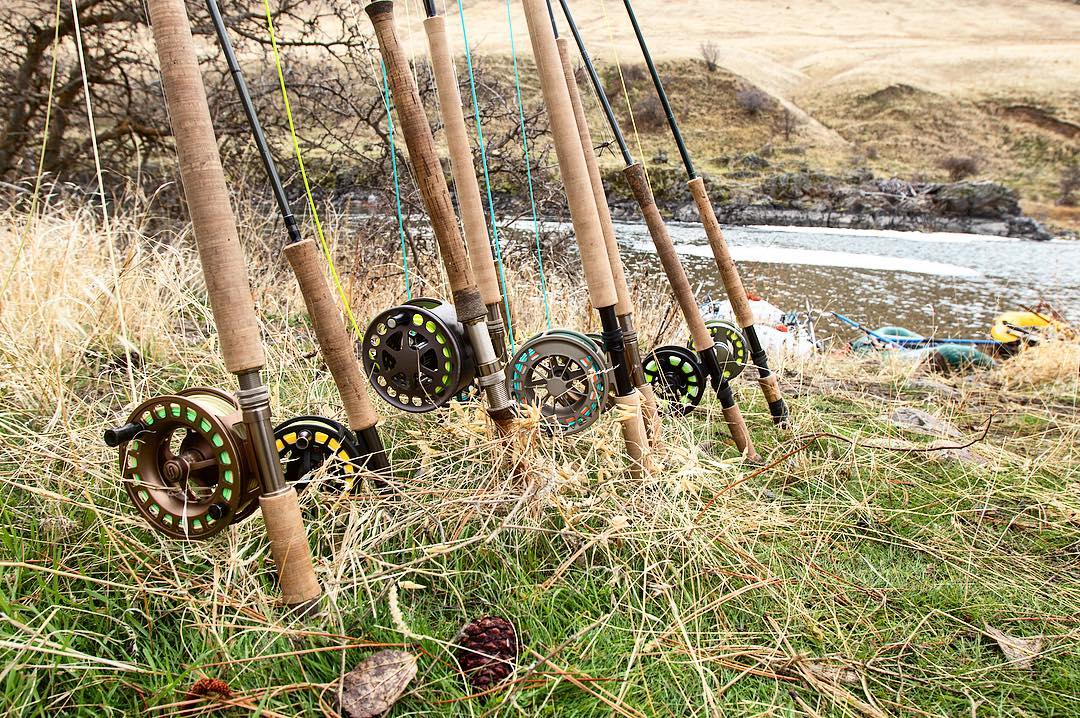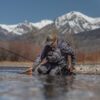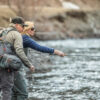“When we are on the water, our contemplative impulses range from
the intense to the nearly absent.” ~Paul Schullery
There are times while fly fishing that an angler’s thoughts, like an arrow, point at the smallest target and others when the mind soars like a Redtail past the river bank, the mountains, and disappears over the horizon. These last days of August, let your contemplative impulses wander.
Silver Creek
The Creek continues to fish well. The Tricos are beginning to thin a bit, but the morning action is still decent. Often the Trico spinner fall coincides with a Betis spinner fall, so have plenty of both patterns in your arsenal. The House of Harrop flies are the best match for these bugs. The Callibaetis hatch is gaining momentum during the middle of the day as well. We have a great variety of patterns to match this hatch, depending on what phase the fish key on. Be sure to have plenty of spinners, duns, and emergers. Callibaetis are one of the few mayflies that can withstand a breeze, and Hackle Stackers are excellent flies for windy conditions. During the heat of the day, especially if there is a wind chop on the water, the hopper fishing has been very good.
Big Wood
The Wood is fishing better than ever! While the easily accessed points are receiving heavy pressure, the best fishing has been in the areas between. The water is low and clear, and the fish are starting to look for all kinds of late summer bugs from terrestrials, like flying ants and hoppers, to smaller Baetis, Tricos, caddis, and Rusty Spinners. With the low water, anglers need to be cautious when approaching the runs. The bigger fish are often waiting to ambush insects in the skinny water at the tail of runs or along the seams. Fish with light tippet (5.5X, 6X or even 6.5X) and small parachute patterns before searching the deeper chutes with large dries and dry dropper rigs. This is a perfect water level to try out Tenkara if you have not yet given it a go. The length of a Tenkara rod gives you incredible control of your presentation and is a fun way to fish a single dry, a dry dropper, or a single nymph, Euro style. For flies, try small (12-16) yellow Stimulators, Parachute Hare’s Ear, Adams, or Purple Haze and for nymphs try a Rubber Legged Stone, Rainbow Warrior, Zebra Midge, or Bishop’s Dynamite.
Upper Big Lost
Because of the cool morning temperatures, the best fishing has shifted from early mornings and late evenings right back to the middle of the day. With the low flows, the fish are concentrated in the deeper buckets, and anglers who are willing to walk from good holding water to the next are finding success. By the day’s end, if you have walked a few miles of river and have a handful of good fish, consider yourself successful. For flies, try small hoppers, caddis, stimulators and other small high vis attractors with a trailing nymph such as a Zebra Midge, a Bishop’s Dynamite, or a Beaded Pheasant Tail.
The Lost Below Mackay
The flows are holding steady at around 330 CFS. The flows may continue to drop as we head into September and the need to irrigate diminishes, so keep an eye on the Idaho Streamflow website. The Trico and Baetis hatches should improve as we head into the end of August as well. Still, nymphing is the most effective method. Try standard dry dropper rigs or fish Euro Style techniques. The best patterns include Rubber Leg Stones, San Juan Worms, and King Princes in the heavy runs. For the shallow water, try small nymphs like Zebra Midge, Bishop’s Dynamite, Beaded Pheasant Tails, and Rainbow Warriors in size 16, 18, and 20 below an attractor dry of your choice. If you find rising fish, have a good selection of high vis Tricos and Baetis. You might also try a dancing large crane fly pattern; we have a great selection of Mackay Specials.
The Salmon
Low water on the Salmon is opening a lot of great walk and wade opportunities above and below the Stanley area. Along the wooded stretches of the river, look for a few Spruce Moths to be fluttering about. Whether you see them or not, try using a tan caddis or stonefly in size 14 to 8 trailed by a smaller beaded nymph like a Pheasant Tail or a Bishop’s Dynamite along the banks or in the shallow riffles above the deeper runs. Swinging black, brown, and olive streamers or buggers can also be productive and you might even find a resident Bull trout.
South Fork of the Boise
The flows have begun to drop and may continue to do so; as of the writing of this report, the flows are around 1250 CFS. It is prime time hopper fishing on the South Fork and working the banks with a variety of hopper patterns in a size 10 or 8 can be effective; however, the fish are quite selective. If you are getting refusals, try a different pattern. Small, tan crane flies are a good pattern to try on selective feeders. Pink Alberts have been emerging in the late afternoon and offer a good opportunity to find some fantastic, but picky, fish on smaller dries and emergers. Nymphing is also very productive with large rubber leg stone fly patterns, caddis larva, and midge patterns.
Local Ponds
Gavers Lagoon, Penny, and Lake Creek ponds have been stocked and would make a great location for a family picnic. Come on by the shop for all your family fishing needs!
Silver Creek Flies: Tricos 22, 24 | PMDs 16 | Beatis 18 | Callibeatis 16 | Hoppers | Damsel Adults and Nymphs | Zebra Midge in black, red, or olive 16,18 | Pheasant Tails 16,18 | Baetis Nymphs
Big Wood, Big Lost, Salmon River Flies: Grasshoppers | Rusty Spinners | Spruce Moth | Elk Hair Caddis | Stimulators | Chubby Chernobyl | Parachute Adams | Pink Alberts | Rubber Legged Stones |Iron Lotus | Pheasant Tails | Bishop’s Dynamite | King Prince | Streamers
South Fork of the Boise Flies: Pink Alberts | Caddis | Hoppers | Rubber Legged Stones | Zebra Midge | Caddis Larva | Flash Back Pheasant tails | King Prince | Streamers
| Silver Creek Big Wood Upper Big Lost The Big Lost Salmon South Fork of the Boise |
96.6 cfs 181 cfs 160 cfs 347 cfs 503 cfs 1050 cfs |




